Who would be best placed next to the recently widowed Lady? Who would be amused by an evening of conversation with the boorish Baron? Would the famous Inventor prefer a more technically minded dinner partner or a sports fan? Which guest would be best to seat along side the Politician?
These are critical problems to solve. Done well, the dinner will be the talk of the town. Done poorly, the whole town will be talking about it for weeks to come.
 This is not a problem we encounter on the farm. No, if we have a dinner party, we simply have to decide whether to add an extra picnic table.
This is not a problem we encounter on the farm. No, if we have a dinner party, we simply have to decide whether to add an extra picnic table.But pasture assignments ARE a challenge. Which horse should go out with which horse, and in which pasture?
Some farms make this easy. Got a mare? She goes in the big field to the left. Got a gelding? Put him in the field to the right with the rest of the boys. Alternatively, some farms provide individual turnout paddocks.
We do neither. First, we believe horses, being herd animals, need pasture mates. Next, we believe that horses need to be matched and grouped on their own merits. And so far, we have found that mixing mares and geldings in small groups of 3 or 4 works just great. And a scientific study helped confirm we are doing well with our horses. In it, it said that geldings are much more likely to relax, roll, and lie down in pasture if a mare is there. Why? Mares are natural nuturers who instinctively watch over the herd. Multiple mares? Even better, as they will take turns watching over the sleeping horses. Very nice. And natural.
So we work hard on finding a good pasture arrangement. And everytime a new horse moves in or a horse moves out, we have to rethink the seating plan. Who goes with whom?
Several weeks ago, a big fairly young horse moved in. Under saddle, but not fully mature and still growing, we put him out with a retired mare who would be most likely to be okay with the amount of grass and winter hay he would require. After the usual scuffles, they hit it off famously. Eating side by side, mutual grooming, missing each other when separated. It was cute. And both owners were pleased to see their horses having best buddies.
More recently, a previously boarded horse moved back in. And of course, seeing her, her old pasture mates were thrilled. So, assigning her pasture was easy. Sometimes it is like that.
Then, last week, we moved the big youngster and his old lady friend to a pasture which had been rested, allowing their pasture to be rested for a few months. The pasture is between two others. One which has 3 geldings, the other which has 2 mares and 1 gelding.
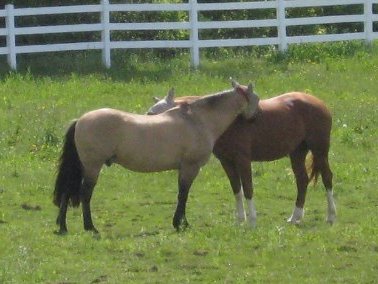 At first, things went just fine. However, within a short amount of time, the big youngster was no longer interested in the retired mare. Instead, he was more interested in a big young gelding on the other side of the fence with two other geldings. All day long, the two big youngsters would play fight, pull off each other's fly masks, and ignore anyone who wanted to bring them in for the night! The two horses bonded over the fence.
At first, things went just fine. However, within a short amount of time, the big youngster was no longer interested in the retired mare. Instead, he was more interested in a big young gelding on the other side of the fence with two other geldings. All day long, the two big youngsters would play fight, pull off each other's fly masks, and ignore anyone who wanted to bring them in for the night! The two horses bonded over the fence.A dinner party disaster! The Baron was ignoring the carefully selected people seated next to him and acting like old mates with the waitor!
Now the challenge. It's seems obvious we should try putting the two big goofballs in a pasture together. But how? What to do with the mare? What about the other geldings who will lose their buddy? Should a third be added to the twosome or with that result in jealousy and fights? And there are other things to consider, such as who's wearing shoes and who's not? And how safe will it be for the owners to extract their horses from the pasture for riding? In general, what are the risks of allowing these two youngsters to play WITHOUT a fence between them?
It's a dilemma, but one we face over and over as horses move in and out, and has horses look beyond their groups and express interest in other horses on the farm. In the end, the solution will either be the talk of the barn, or talked about all over barn.
 In August, we saw Tropical Storm Irene. We suffered no damage here, thank goodness. We were very lucky and only had a strong summer rainstorm. Can't say the same for our neighbors in Vermont, however! Yikes!
In August, we saw Tropical Storm Irene. We suffered no damage here, thank goodness. We were very lucky and only had a strong summer rainstorm. Can't say the same for our neighbors in Vermont, however! Yikes! 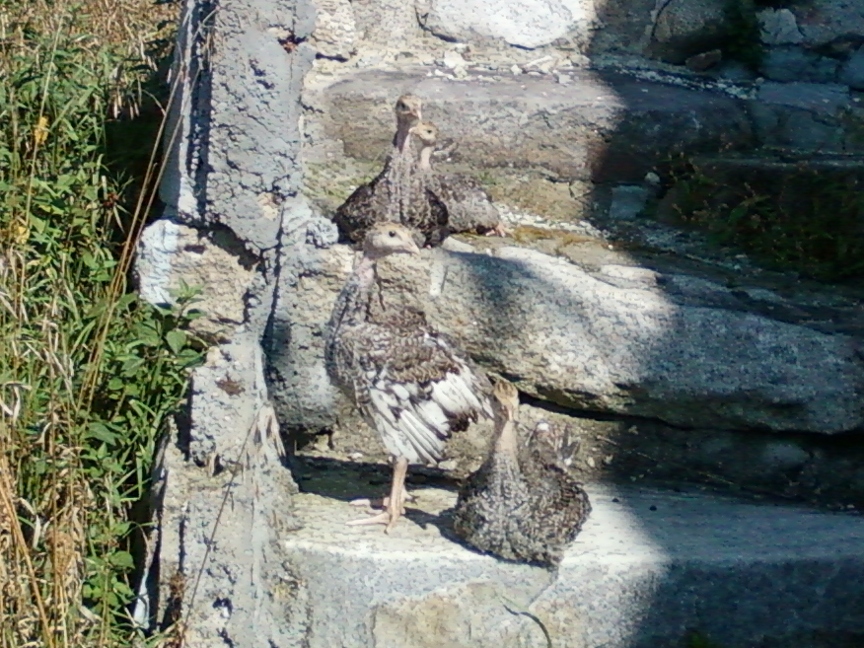 Meanwhile, as time continues to march on, we're finally seeing wonderful growth in our Thanksgiving turkeys. We purchased our lovely Bronze Turkey poults in late July. It was not until October that we started to believe they would be more than "rock cornish game hens" by TG. Now, the difference in their size, week by week, is truly evident. They will be good sized in time for "the end".
Meanwhile, as time continues to march on, we're finally seeing wonderful growth in our Thanksgiving turkeys. We purchased our lovely Bronze Turkey poults in late July. It was not until October that we started to believe they would be more than "rock cornish game hens" by TG. Now, the difference in their size, week by week, is truly evident. They will be good sized in time for "the end". When done, the mixture has a pleasant consistency which is easy to apply on the legs. Since we use the tropical green No-Ad Aloe After Sun Gel, the final mixture is a very appetizing pale green in color, kind of like Key Lime Pie. So don't leave it on the kitchen counter!
When done, the mixture has a pleasant consistency which is easy to apply on the legs. Since we use the tropical green No-Ad Aloe After Sun Gel, the final mixture is a very appetizing pale green in color, kind of like Key Lime Pie. So don't leave it on the kitchen counter!
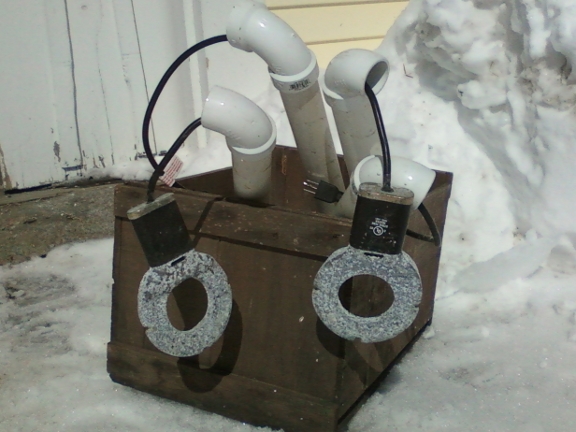 For the aeration system to work, more air would need to be used, which means more power, more electricity, more costs! And the motion of the water would probably be so intense that the horses would not want to drink from it anyway. And there is the question of whether they would drink the water if it were colder than a slush puppy?
For the aeration system to work, more air would need to be used, which means more power, more electricity, more costs! And the motion of the water would probably be so intense that the horses would not want to drink from it anyway. And there is the question of whether they would drink the water if it were colder than a slush puppy? ....the warm weather was immediately followed by a wicked cold snap with temps dropping back into the single digits at night. During the transition from practically balmy weather to downright artic weather, I failed to take the little de-icer off the timer. Sure enough, it became imbedded in a couple inches of ice at the bottom of a trough. It took a long time before it was able to free itself clear of the ice and start working on the water again.
....the warm weather was immediately followed by a wicked cold snap with temps dropping back into the single digits at night. During the transition from practically balmy weather to downright artic weather, I failed to take the little de-icer off the timer. Sure enough, it became imbedded in a couple inches of ice at the bottom of a trough. It took a long time before it was able to free itself clear of the ice and start working on the water again.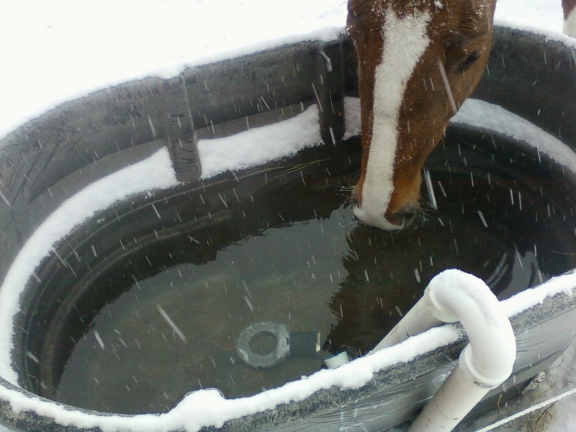 Plan B - Continuous Movement Through ..... TBD
Plan B - Continuous Movement Through ..... TBD 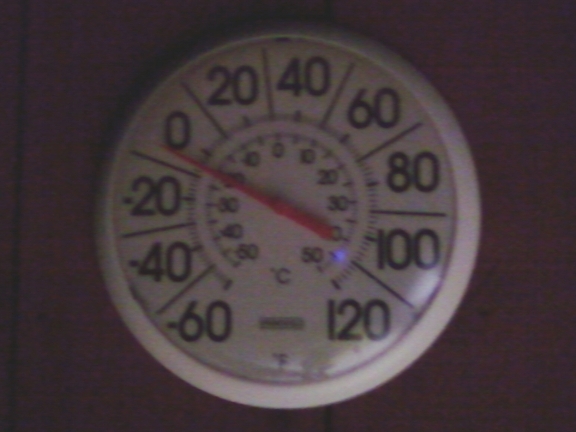 After a relatively mild December, January has really provided a very sharp reminder of just how cold and snowy it can get in New Hampshire! And February is already looking to be just as wintery!
After a relatively mild December, January has really provided a very sharp reminder of just how cold and snowy it can get in New Hampshire! And February is already looking to be just as wintery!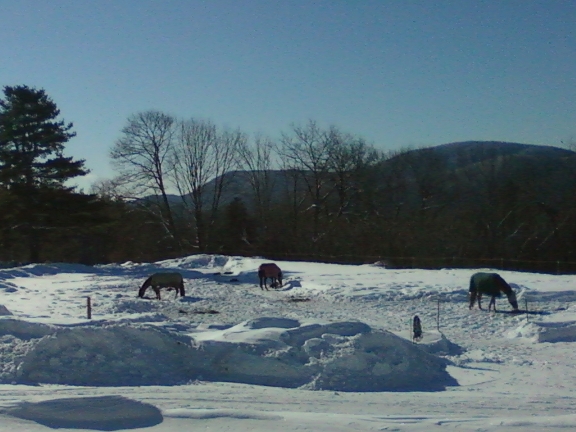 Since we plow the pastures, the horses always have space to "graze" on their hay without stomping through deep snow. But even providing that luxury may become a challenge as the storms keep rolling in.
Since we plow the pastures, the horses always have space to "graze" on their hay without stomping through deep snow. But even providing that luxury may become a challenge as the storms keep rolling in.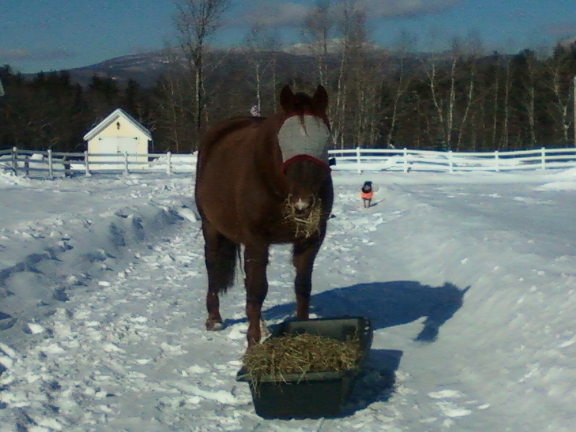 It may have been a serious fashion faux pas, but it worked surprisingly well. My eyes were sufficiently protected. Watch. Flymasks will be all the rage next winter, on horses AND their owners! :-)
It may have been a serious fashion faux pas, but it worked surprisingly well. My eyes were sufficiently protected. Watch. Flymasks will be all the rage next winter, on horses AND their owners! :-) 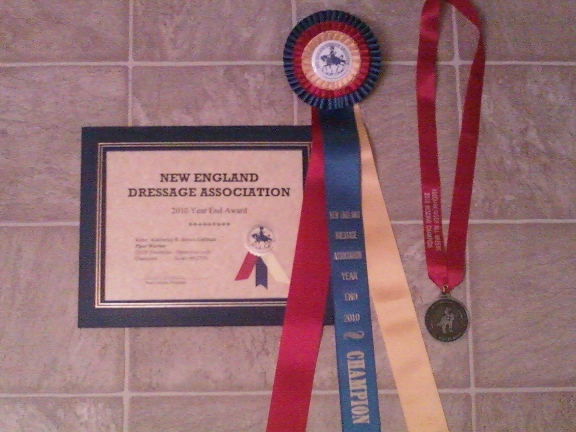 By the end of 2010, Kearsarge Meadows lesson horse Piper Warrior and farm owner Kimberley had achieved their 2010 dressage goals, and then some. They made it to the 2010 USDF Region 8 Championships in 3 categories! And they finished 2010 with several National & New England Dressage Association (NEDA) year end awards, including:
By the end of 2010, Kearsarge Meadows lesson horse Piper Warrior and farm owner Kimberley had achieved their 2010 dressage goals, and then some. They made it to the 2010 USDF Region 8 Championships in 3 categories! And they finished 2010 with several National & New England Dressage Association (NEDA) year end awards, including: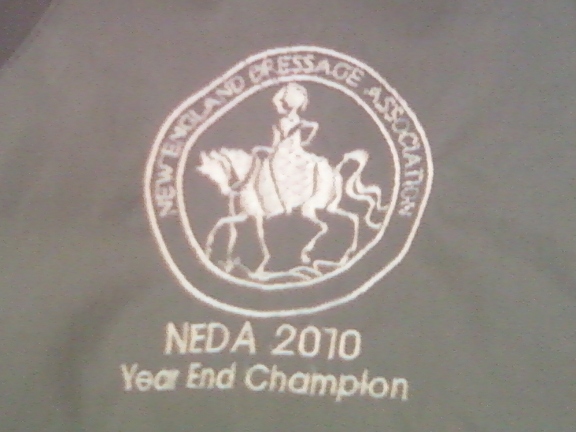 The 2010 NEDA Year End Championship for USDF Freestyles came with a massive championship ribbon and a gorgeous embroidered Mountain Horse jacket. Very nice!
The 2010 NEDA Year End Championship for USDF Freestyles came with a massive championship ribbon and a gorgeous embroidered Mountain Horse jacket. Very nice!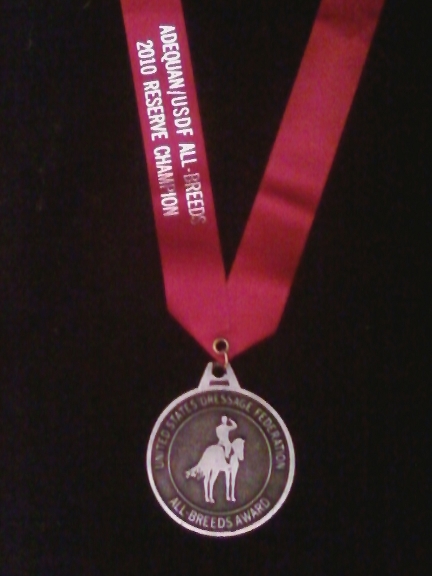 Anyone looking at Piper this morning would find it a little difficult to imagine the woolly black warmblood ready to compete again in four months time, but that is part of this year's game plan. Well, that's only if he does not sell before then. (Click here to view
Anyone looking at Piper this morning would find it a little difficult to imagine the woolly black warmblood ready to compete again in four months time, but that is part of this year's game plan. Well, that's only if he does not sell before then. (Click here to view 